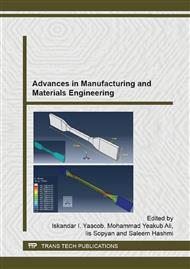[1]
M. Sakurai, Target Costing and How to Use It, Journal of Cost Management for the Manufacturing Industry. (1989). 39-50.
Google Scholar
[2]
T. Tani, P. Horváth, and S. Wangenheim, Genka Kikaku and market-oriented Target Cost Management - German-Japanese system compared to Development and dissemination, controlling, (1996), 80-89.
Google Scholar
[3]
S.L. Ansari & J. Bell, Target costing: The Next Frontier in Strategic Cost Management. USA: MacGraw-Hall, (1997).
Google Scholar
[4]
E. Y. T. Adesta, M. H. F. Al Hazza, M. Riza, D. Agusman, Rosehan. Tool Life Estimation Model Based on Simulated Flank Wear during High Speed Hard Turning. European Journal of Scientific Research, Vol. 39. (2010), 265-278.
DOI: 10.4028/www.scientific.net/amr.264-265.1097
Google Scholar
[5]
U. Khandey, Optimization of surface roughness, material removal rate and cutting tool flank wear in turning using extended taguchi approach (2009). (Doctoral dissertation).
Google Scholar
[6]
E. Y. T. Adesta, M. H. F. Al Hazza, M. Agusman, & A. G. E. Sutjipto, Development of Tooling Cost Model for High Speed Hard Turning. Advanced Materials Research, 418, (2012)1482-1485.
DOI: 10.4028/www.scientific.net/amr.418-420.1482
Google Scholar
[7]
S. Gara, W. Bouzid, M. Hbaieb, & M. B. Amar, Cutting speed optimization in high speed turning. International Review of Mechanical Engineering (IREME), 1(3), (2007) 237-244.
Google Scholar
[8]
S. Gara, W. Bouzid, M.B. Amar, & M. Hbaieb, Cost and time calculation in rough NC turning. The International Journal of Advanced Manufacturing Technology, 40(9-10), (2009) 971-981.
DOI: 10.1007/s00170-008-1417-5
Google Scholar
[9]
E. Y. T. Adesta & M. H. F. Al Hazza. Machining Time Simulation in High Speed Hard Turning. Advanced Materials Research, Volumes 264-265, (2011), 1102 -1106.
DOI: 10.4028/www.scientific.net/amr.264-265.1102
Google Scholar
[10]
M. Kuhn, The desirability Package. Journal of Quality Technology 12, (2012) 214-219.
Google Scholar
[11]
S., Alam, A. K. M., Nurul Amin, M., Konneh, & A. U. Patwari. Surface roughness prediction in high speed flat end milling of Ti-6AL-4V and optimization by desirability function of RSM. Advanced Materials Research, 264, (2011)1166-1173.
DOI: 10.4028/www.scientific.net/amr.264-265.1166
Google Scholar
[12]
A. R., Alao, & M. Konneh, Surface finish prediction models for precision grinding of silicon. The International Journal of Advanced Manufacturing Technology, 58(9-12), (2012). 949-967.
DOI: 10.1007/s00170-011-3438-8
Google Scholar


